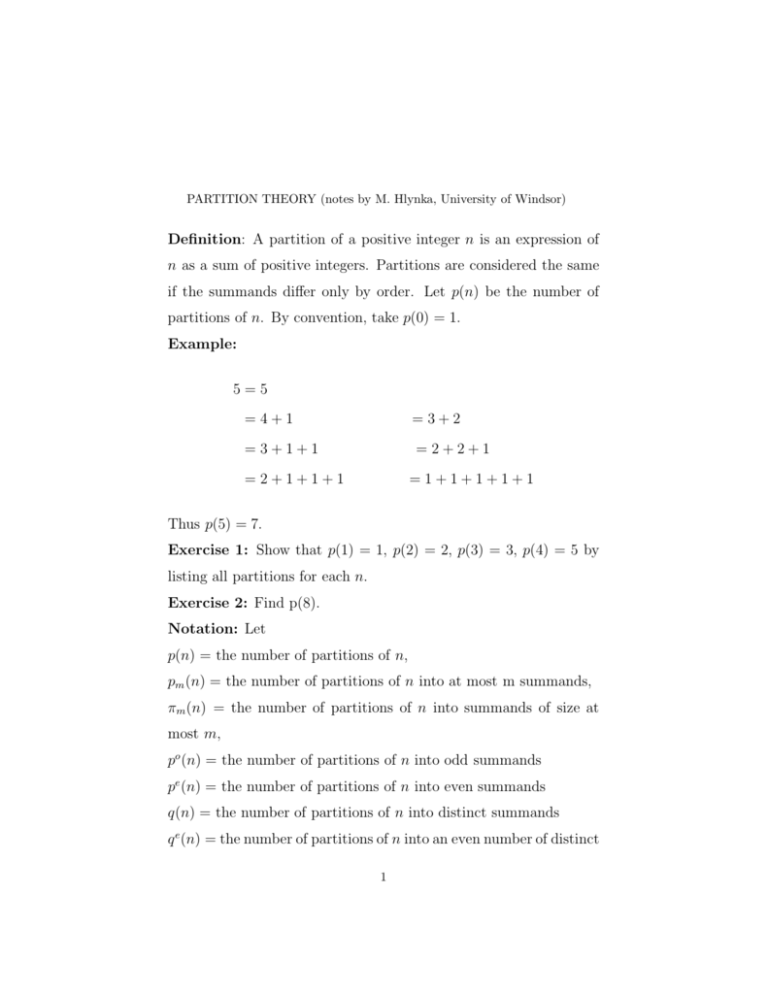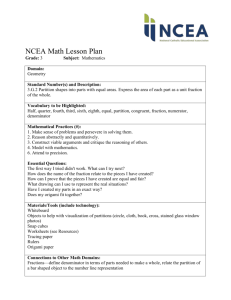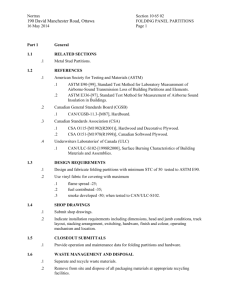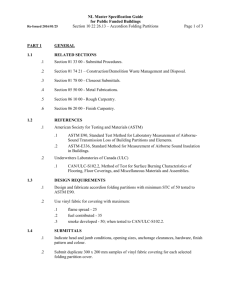Definition: A partition of a positive integer n is an expression of n as
advertisement

PARTITION THEORY (notes by M. Hlynka, University of Windsor) Definition: A partition of a positive integer n is an expression of n as a sum of positive integers. Partitions are considered the same if the summands differ only by order. Let p(n) be the number of partitions of n. By convention, take p(0) = 1. Example: 5=5 =4+1 = 3+2 = 3+1+1 = 2+2+1 = 2+1+1+1 =1+1+1+1+1 Thus p(5) = 7. Exercise 1: Show that p(1) = 1, p(2) = 2, p(3) = 3, p(4) = 5 by listing all partitions for each n. Exercise 2: Find p(8). Notation: Let p(n) = the number of partitions of n, pm (n) = the number of partitions of n into at most m summands, πm (n) = the number of partitions of n into summands of size at most m, po (n) = the number of partitions of n into odd summands pe (n) = the number of partitions of n into even summands q(n) = the number of partitions of n into distinct summands q e (n) = the number of partitions of n into an even number of distinct 1 summands q o (n) = the number of partitions of n into an odd number of distinct summands. Property 1: πm (n) = πm−1 (n) + πm (n − m) for n ≥ m > 1. Proof. For each partition counted in pm−1 (n), we can add 1 to get a partition of n into parts of size less than m. Any other partition of n counted in pm (n) must have m as one of its summands. Other summands are ≤ m. So we can find the remaining partitions counted in pm (n) by taking all partitions counted in pm (n) and adding the summand m to them. The result follows. Note: (a) πn (n) = p(n) since all partitions of n have summands at most n. (b) π1(n) = 1 since n = 1 + · · · + 1. Thus we can use the Property P1 to recursively find p(n). bf Example: Find p(7). p(7) = π7(7) = π6(7) + π7(7 − 7) = π6 (7) + 1 = π5 (7) + π6(7 − 6) + 1 = π5(7) + π6(1) + 1 = π5 (7) + 1 + 1 = π4(7) + π5 (2) + 2 = π4(7) + 4 = π3(7) + π4 (3) + 4 = π3 (7) + 3 + 4 = π2(7) + π3(4) + 7 = π1 (7) + π2 (5) + π2(4) + π3(1) + 7 = 1 + π1 (5) + π2(3) + π1(4) + π2(2) + 1 + 7 = 1 + 1 + 2 + 1 + 2 + 1 + 7 = 15 Exercise 3 Find p(8) using the recursive property. Graphical Representation A partition can be written with a graphical representation, known 2 as a Ferrers graph, named after the British mathematician Norman Macleod Ferrers. See http://www.gap-system.org/∼history/Biographies/Ferrers.html For example 3 + 2 can be written as * * * * * As another example, the graphical representation * * * * * * * * represents the partition 4+3+1. Conjugate Graph The conjugate graph is obtained from a graph by writing the rows as columns. The conjugate graphs for the two previous graphs are * * * * * * * * * * and * * * The two corresponding partitions are 2 + 2 + 1 and 3 + 2 + 2 + 1. Self Conjugate Partitions A partition is said to be self conjugate if its graph and the conjugate of the its graph are the same. Example The partition 4+3+3+1 is self conjugate because the graph is 3 * * * * * * * * * * * * * * * * * * with conjugate * * * * Property 2: The number of partitions of n into self conjugate parts equals the number of partitions of n into distinct odd parts. Proof. Every self conjugate partition maps to partition into distinct odd parts by reading off the nested L shaped sections. Conversely, any odd part can be folded into an L shape and by nesting these, we get a self conjugate partition. Example: The self conjugate partition 4+3+3+1 (of 10) has graph * * * * * * * * * * * The partition 7+3+1 (of 11) into distinct odd parts can be converted to L shapes and nested to give x x x y z x y y x x x x x The corresponding self conjugate part is 5+3+3+1+1. Example There are 3 partitions of 12 into distinct odd parts and 3 partitions 4 of 12 into self conjugate parts. The correspondence is 11 + 1 ↔ 6 + 2 + 1 + 1 + 1 + 1 9+3↔ 5+3+2+1+1 7+5↔ 4+4+2+2 Exercise 4 Find all partitions of 13 into distinct odd parts and find the corresponding self adjoint partition for each. Exercise 5 Find all self conjugate partitions of 14. Find the corresponding partition of each into distinct odd parts. Property 3: The number of partitions of n into at most m parts is the number of partitions into parts whose largest part is at most m. i.e. pm (n) = πm (n). Proof: Exercise 6: Give a proof based on Ferrar’s Diagram. Exercise 7: The number of partitions of n into exactly k parts is the number of partitions into parts such that . Generating Functions for Partitions The generating function f1 (x) = (1 + x + x1+1 + x1+1+1 + . . . ) = (1 + x + x2 + x3 + . . . ) gives the number of partitions of i into parts all of size 1 as the coefficient of xi. The generating function f2 (x) = (1 + x + x2 + x3 + . . . )(1 + x2 + x4 + x6 + . . . ) = 1 + x1 + 2x2 + 2x3 + 3x4 + . . . gives the number of partitions of i into parts of size 1 or 2 as the coefficient of xi . 5 The generating function f3(x) = (1 + x + x2 + . . . )(1 + x2 + x4 + . . . )(1 + x3 + x6 + . . . ) . . . X = 1 + x1 + 2x2 + 3x3 + 5x4 + · · · = p(i)xi gives the number of partitions of i as the coefficient of xi . Exercise 8: (a) What is the generating function for partitions into odd parts? (b) What is the generating function for partitions into distinct parts? (c) What is the generating function for partitions into odd parts which can be repeated at most three times? Note Issues of convergence will be ignored. The x terms afre simply place holders. However, we can manipulate the series as if they Property 4: The number of partitions of n into odd parts equals the number of partitions of n into distinct parts. i.e. po (n) = q(n). PROOF. The generating function for partitions into odd parts is g1 (x) = (1 + x + x2 + . . . )(1 + x3 + x6 + . . . )(1 + x5 + x10 + . . . ) . . . 6 The generating function for partitions into distinct parts is 2 3 4 g2 (x) = (1 + x)(1 + x )(1 + x )(1 + x ) · · · = n Y (1 + xi ) i=1 2 4 6 1−x 1−x 1−x ... 1 − x 1Q − x2 1 − x3 ∞ 1 − x2i ) i=1 (1 Q = Q∞ = Qn ∞ 2i 2i−1 2i−1 ) ) i=1 (1 − x ) i=1 (1 − x i=1 (1 − x = = (1 + x + x2 + . . . )(1 + x3 + x6 + . . . )(1 + x5 + x10 + . . . ) . . . The result follows. Exercise 9: Use the method in the above property to show that every positive integer can be expressed uniquely as a sum of powers of 2, with each power appearing at most once (i.e. there is a unique representation in base 2). Exercise 10: Use the method in the property to show that the number of partitions into parts that appear at most twice is equal to the number of partitions into parts not divisible by 3. SOLUTION: Let f(x) be the generating function for parts that appear at most twice. Then f(x) = (1 + x + x2)(1 + x2 + x4 ) · · · . Let g(x) be the generating function for parts that are not divisible by 7 3. Then g(x) = (1 + x + x2 + . . . )(1 + x2 + x4 + . . . )(1 + x4 + x8 + . . . ) (1 + x5 + x10 + . . . ) · · · Thus g(x) = (1 + x + x2 + . . . )(1 + x2 + x4 + . . . )(1 + x4 + x8 + . . . ) · · · 1 1 1 1 = ··· 1−x 1 − x2 1 − x4 1 − x5 1 =Q i i6≡0 mod 3 (1 − x ) Q (1 − x3i ) Q Q =Q (1 − x3i ) (1 − x3i+1 ) (1 − x3i+2 ) Q (1 − x3i ) 1 − x3 1 − x6 1 − x9 = Q = ··· (1 − xi ) 1−x 1 − x2 1 − x3 = (1 + x + x2)(1 + x2 + x4 )(1 + x3 + x6) · · · = f(x) 8









